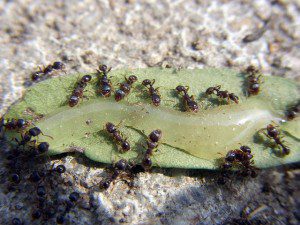Pavement Ants do sting!
By Chris Williams on March 17, 2016.
 Well its nearly mid February and it really feels like winter outside today with temperatures in the low twenties. What is up with that? The further along we get in this crazy winter and its getting colder instead of moderating. But, pavement ants are starting to show up now in homes and businesses. What species is the pavement ant? There are lots of ant species that live in the ground in and around structures, but they’re not all ‘pavement’ ants. I’ve got plenty of the ‘real’ ones (Tetramorium caespitum) living in my border gardens, driveway and around my crumbling concrete walkways. The pavement ant is a non native species that was probably introduced to the US via shipping vessels from Europe during the founding of the country. It is thought that the ants may have been carried in the soil used for ballast in these cargo ships which was routinely dumped once the ships reached reached port. (http://ento.psu.edu/extension/factsheets/pavement-ant.
Well its nearly mid February and it really feels like winter outside today with temperatures in the low twenties. What is up with that? The further along we get in this crazy winter and its getting colder instead of moderating. But, pavement ants are starting to show up now in homes and businesses. What species is the pavement ant? There are lots of ant species that live in the ground in and around structures, but they’re not all ‘pavement’ ants. I’ve got plenty of the ‘real’ ones (Tetramorium caespitum) living in my border gardens, driveway and around my crumbling concrete walkways. The pavement ant is a non native species that was probably introduced to the US via shipping vessels from Europe during the founding of the country. It is thought that the ants may have been carried in the soil used for ballast in these cargo ships which was routinely dumped once the ships reached reached port. (http://ento.psu.edu/extension/factsheets/pavement-ant.
Pavement ant workers are 1/8-inch long, (reproductive ants are about twice that size) and reddish brown with distinct grooves on the head and thorax. This ant has two nodes, and a stinger on the end of the third segment (abdomen). It is generally slow moving, and will form strong trails to food sources. I’ve had them enter my home a few times over the years forming a line right towards the cat’s food dish. Pavement ant colonies mostly reside below various type of paved surfaces like walkways, stone walls, foundation slabs etc. (they’re well named!) I’ve observed them coming through minor cracks in my foundation, and also pushing out sand and other debris (mostly dead insects) from some gaps at the top of my foundation wall. A little treatment with an insecticide dust, and a lot of sealing up cracks with caulking seems to have worked to keep them out of my basement. Pavement ants are one of the easier species to bait and and non repellent insecticide sprays can further enhance control. The pavement ant has a stinger and will use it as I found out last summer while doing a perimeter treatment on a home. I had unknowingly stepped on a nest in some loose soil and it didn’t take them long at all to get on my socks and exposed skin and begin attacking me. I definitely felt it and after I brushed them off my clothing, I went and took care of business!
Photo Credit : Fractality | CC BY 2.0